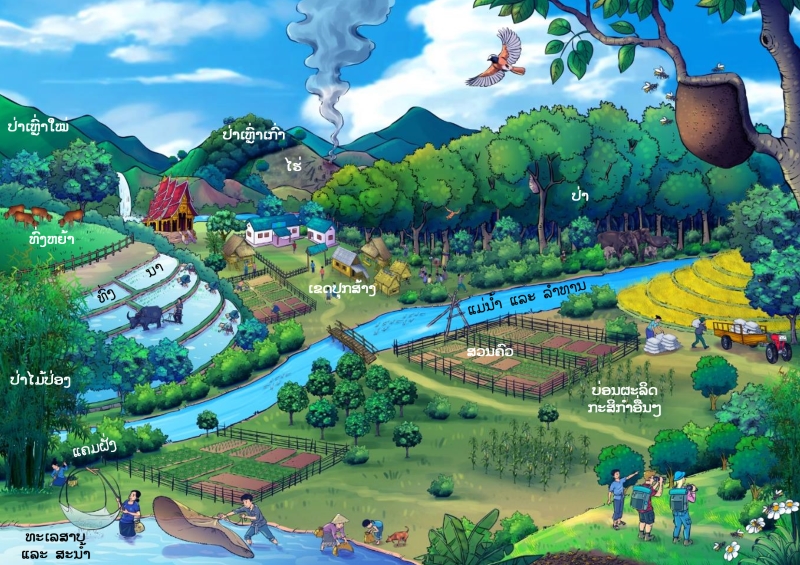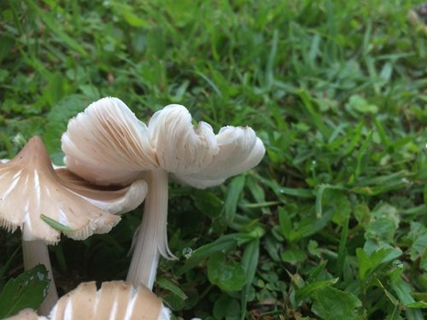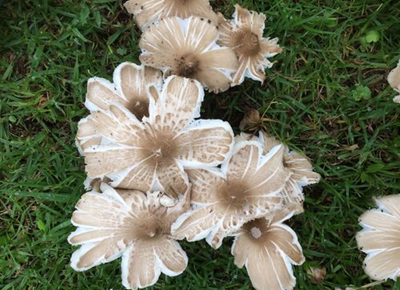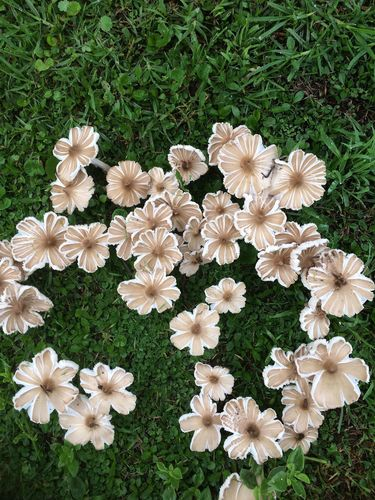ເລກລຳດັບທີ: 132
ລະດັບການຮວບຮວມຂໍ້ມູນ: ເກີອບສົມບູນ
ປັບປູງຄັ້ງລ່າສຸດ: 2024-10-12
ເຫັດປວກ
Termite Mushroom
Termitomyces clypeatus R. Heim
ເຊື້ອເຫັດ
ເຊື້ອຣາທີ່ເກີດຕາມດິນ
×
ຊື່ທ້ອງຖີ່ນ:
ເຫັດປວກຈິດ
ຊື່ພ້ອງ
:
Termitomyces clypeatus R.Heim
Sinotermitomyces taiwanensis M.Zang & C.M.Chen
Sinotermitomyces taiwanensis M.Zang & C.M.Chen
ຊື່ສະກຸນ:
Lyophyllaceae
ຊະນິດໃກ້ຄຽງ:
ເຫັດເຜາະ/ Hygroscopic Earthstar
ເຫັດໄຄ/ Green-cracking Russula
ເຫັດໜວດສີຂາວ / crown-tipped mushroom
ເຫັດຄ້ອນກອງ / Graceful parasol mushroom
ເຫັດໂຕ່ງຝົນໃຫຍ່ / Swine’s stomach mushroom
ເຫັດຂີ້ມ້າ/ Horse Mushroom
ເຫັດຂອນຂາວ/ White Log Mushroom
ເຫັດໄຂ່ຫ່ານ/ Head Man Slender Caesa
ເຫັດຫອມ/ Shiitake mushroom
ເຫັດຖ່ານ/ Charcoal Russula
ເຫັດໄຄ/ Green-cracking Russula
ເຫັດໜວດສີຂາວ / crown-tipped mushroom
ເຫັດຄ້ອນກອງ / Graceful parasol mushroom
ເຫັດໂຕ່ງຝົນໃຫຍ່ / Swine’s stomach mushroom
ເຫັດຂີ້ມ້າ/ Horse Mushroom
ເຫັດຂອນຂາວ/ White Log Mushroom
ເຫັດໄຂ່ຫ່ານ/ Head Man Slender Caesa
ເຫັດຫອມ/ Shiitake mushroom
ເຫັດຖ່ານ/ Charcoal Russula
ບັນຍາຍລັກສະນະທາງພືດສາດ:
ເຫັດຊະນິດນີ້ມີຂະໜາດປານກາງ ແລະ ມີລັກສະນະເປັນຮູບຈວຍ ກ່ອນທີ່ຈະບານອອກ, ລັກສະນະປຸ່ມເຄິ່ງກາງເປັນສີເຂັ້ມ ແລະ ແຫຼມ. ໝວກເຫັດມີຂະໜາດ 50 ຫາ 150 ມມ. ມີຄວາມໜຽວເລັກນ້ອຍ ແລະ ປົກຫຸ້ມດ້ວຍຂົນລະອຽດ. ມີສີເທົາຫາສີນ້ຳຕານອ່ອນ, ໂດຍບໍລິເວນຂອບຈະມີສີອ່ອນກວ່າ ແລະ ແຕກອອກບໍ່ສະໝໍ່າສະເໝີ. ເຫງືອກ (ແຜ່ນໃບດ້ານລຸ່ມ) ຈັບຮຽງກັນຢ່າງໜາແໜ້ນ ແລະ ຂ້ອນຂ້າງອອກຫາງຈາກກ້ານ. ກ້ານເຫັດມີຄວາມຍາວ 100 ຫາ140 ມມ. ແລະ ໜາ 2-6 ມມ., ບໍລິເວນໂຄນກ້ານຈະບວມອອກເລັກໜ້ອຍ, ບໍ່ມີວົງແຫວນຢູ່ກ້ານ ໂຄນກ້ານເປັນສີຂາວ, ແຂງ ແລະ ເປັນສັນ (ມີລາຍ) ເອີ້ນວ່າ pseudorhiza ເຊິ່ງຈະແຄບລົງເມື່ອແກ່ [4].
ໝາຍເຫດ: ເຫັດປວກ T. clypeatus ທີ່ພົບໃນເອເຊຍ, ເປັນສາຍພັນທີ່ຖືກອະທິບາຍໂດຍ Congo ແລະ ຂໍ້ມູນໂມເລກຸນຊີ້ໃຫ້ເຫັນວ່າ Termitomyces ໃນເອເຊຍແຕກຕ່າງກັບສາຍພັນຂອງອາຟຣິກາ [5].
ໝາຍເຫດ: ເຫັດປວກ T. clypeatus ທີ່ພົບໃນເອເຊຍ, ເປັນສາຍພັນທີ່ຖືກອະທິບາຍໂດຍ Congo ແລະ ຂໍ້ມູນໂມເລກຸນຊີ້ໃຫ້ເຫັນວ່າ Termitomyces ໃນເອເຊຍແຕກຕ່າງກັບສາຍພັນຂອງອາຟຣິກາ [5].
ນິເວດວິທະຍາ
ເຂດກະຈາຍພັນທົ່ວໂລກ:
Kenya, South Africa, Lao, Nepal, Canada, China, Thailand
ເຂດກະຈາຍພັນໃນລາວ
:
ເຂດພູສູງພາກເໜືອຂອງລາວ
ເຂດພູສູງສາຍພູຫຼວງ ແລະ ເຂດພູພຽງແຂວງຊຽງຂວາງ
ເຂດພູສູງສາຍພູຫຼວງ ແລະ ເຂດພູພຽງແຂວງຊຽງຂວາງ

ເຂດກະຈາຍພັນຕາມພູມສັນຖານ
:
ປ່າດົງດິບ
ປ່າປະສົມປ່ຽນໃບ
ປ່າໂຄກ
ປ່າແປກ
ປ່າແປກປະສົມປ່າໃບກ້ວາງ
ປ່າປູກ
ປ່າໄມ້ປ່ອງ
ແຄມຝັ່ງນໍ້າ
ເຂດຜະລິດພືດຜົນເນີນສູງ
ປ່າເຫຼົ່າອ່ອນ
ປ່າເຫຼົ່າແກ່
ເຂດກະສິກຳອື່ນໆ
ປ່າປະສົມປ່ຽນໃບ
ປ່າໂຄກ
ປ່າແປກ
ປ່າແປກປະສົມປ່າໃບກ້ວາງ
ປ່າປູກ
ປ່າໄມ້ປ່ອງ
ແຄມຝັ່ງນໍ້າ
ເຂດຜະລິດພືດຜົນເນີນສູງ
ປ່າເຫຼົ່າອ່ອນ
ປ່າເຫຼົ່າແກ່
ເຂດກະສິກຳອື່ນໆ

ສະເພາະຖິ່ນໃນລາວ:
ພື້ນເມືອງ
ຮຸກຮານ
:
ບໍ່ຮຸກຮານ
ສະຖານະພາບການອະນູຮັກ IUCN
:
ບໍ່ມີຄວາມສ່ຽງ
ສະຖານະພາບການອະນຸຮັກແຫ່ງຊາດລາວ
:
ບໍ່ຖືກລະບຸໃນບັນຊີປະເພດໃດ
ການນຳໃຊ້
ປະເພດການນຳໃຊ້:
ອາຫານ
ບັນຍາຍການນຳໃຊ້:
ອາຫານ: ໃຊ້ປຸ່ງແຕ່ງອາຫານເປັນຕົ້ນແມ່ນ ແກງ, ຕົ້ມ, ຂົ້ວ, ແລະ ນຳມາຕຳແຈ່ວ. ເຫັດມີເນື້ອ ແລະ ລົດຊາດຫວານເລັກນ້ອຍ. ບາງຄັ້ງຖືກນຳມາຕາກໃຫ້ແຫ້ງ ແລະ ເອົາມາບົດເປັນຜົງ ເພື່ອໃຊ້ເປັນເຄື່ອງປຸງໄດ້ [7].
ການປູກ ການລ້ຽງ:
ຊະນິດທຳມະຊາດ
ລະດູການເກັບກູ້:
ມິຖຸນາ
ກໍລະກົດ
ສິງຫາ
ກັນຍາ
ກໍລະກົດ
ສິງຫາ
ກັນຍາ
ການຕະຫຼາດ ແລະ ຕ່ອງໂສ້ມູນຄ່າ:
ໃນຊ່ວງລະດູທີ່ເຫັດປວກອອກ ຊາວບ້ານຈະອອກໄປເກັບໃນປ່າເພື່ອມາຂາຍຢູ່ຕາມຕະຫຼາດທ້ອງຖິ່ນ ແລະ ຂາຍໃຫ້ກັບພໍ່ຄ້າຄົນກາງຈຳນວນຫຼາຍ ເພື່ອນຳໄປຂາຍຕໍ່ [8].
ເຫັດປວກເປັນແຫຼ່ງລາຍຮັບທີ່ສໍາຄັນສໍາລັບປະຊາຊົນຈໍານວນຫຼາຍໃນລາວ. ເຫັດເຫຼົ່ານີ້ຈະຖືກເກັບມາຈາກປ່າແລ້ວຂາຍຕາມທ້ອງຕະຫຼາດ ຫຼື ຮ້ານອາຫານ, ເຫັດເຫຼົ່ານີ້ສາມາດຂາຍໄດ້ໃນລາຄາສູງ ປະມານ 300,000 ກີບ/kg (ລາຄາໃນປີ 2024 ຂາຍຕາມຕະຫຼາດໃນນະຄອນຫຼວງ ແລະ ອອນໄລນ), ໂດຍສະເພາະໃນລະດູແລ້ງເພາະມີຈໍານວນໜ້ອຍ ບໍ່ພຽງພໍຕໍ່ກັບຄວາມຕ້ອງການຂອງຕະຫຼາດ [8].
ການປະເມີນການນຳໃຊ້ອາຫານຈາກທຳມະຊາດ ໄດ້ເຮັດໃຫ້ຮູ້ວ່າ ຄວາມຕ້ອງການທາງທ້ອງຕະຫຼາດແມ່ນເພີ່ມຂຶ້ນທຸກໆປີ [11]
ເຫັດປວກເປັນແຫຼ່ງລາຍຮັບທີ່ສໍາຄັນສໍາລັບປະຊາຊົນຈໍານວນຫຼາຍໃນລາວ. ເຫັດເຫຼົ່ານີ້ຈະຖືກເກັບມາຈາກປ່າແລ້ວຂາຍຕາມທ້ອງຕະຫຼາດ ຫຼື ຮ້ານອາຫານ, ເຫັດເຫຼົ່ານີ້ສາມາດຂາຍໄດ້ໃນລາຄາສູງ ປະມານ 300,000 ກີບ/kg (ລາຄາໃນປີ 2024 ຂາຍຕາມຕະຫຼາດໃນນະຄອນຫຼວງ ແລະ ອອນໄລນ), ໂດຍສະເພາະໃນລະດູແລ້ງເພາະມີຈໍານວນໜ້ອຍ ບໍ່ພຽງພໍຕໍ່ກັບຄວາມຕ້ອງການຂອງຕະຫຼາດ [8].
ການປະເມີນການນຳໃຊ້ອາຫານຈາກທຳມະຊາດ ໄດ້ເຮັດໃຫ້ຮູ້ວ່າ ຄວາມຕ້ອງການທາງທ້ອງຕະຫຼາດແມ່ນເພີ່ມຂຶ້ນທຸກໆປີ [11]
ການຄຸ້ມຄອງຈັດການ
N/A
ໂພຊະນາການ
ຄຸນຄ່າທາງໂພຊະນາການ:
ແຫຼ່ງໂປຣຕີນທີ່ສຳຄັນ
ແຫຼ່ງຄາໂບໄຮເດຣດທີ່ສຳຄັນ
ແຫຼ່ງເສັ້ນໃຍທີ່ສຳຄັນ
ແຫຼ່ງຄາໂບໄຮເດຣດທີ່ສຳຄັນ
ແຫຼ່ງເສັ້ນໃຍທີ່ສຳຄັນ
ບັນຍາຍຄຸນຄ່າທາງໂພຊະນາການ:
N/A
| ສານອາຫານ | /100g | ໝາຍເຫດ |
|---|---|---|
| ໂປຣຕີນ | 26.34 | N/A |
| ຄາໂບໄຮເດຣດ | 27.67 | N/A |
| ໄຂມັນ | 7.9 | N/A |
| ວິຕາມິນ | N/A | N/A |
| ແຮ່ທາດ | N/A | N/A |
| ເສັ້ນໄຍ | 35.15 | N/A |
ອ້າງອິງ
ເຄດິດຮູບພາບ:
Termite Mushroom from the side. [1] iNaturalist [Online]. Uploaded on 25 November 2019 by: mamerle. Available: www.inaturalist.org/photos/56938571. [Accessed: 18 September 2024]
Termite Mushroom from the top, close up. [2] iNaturalist [Online]. Uploaded on 25 November 2019 by: mamerle. Available: www.inaturalist.org/photos/56938546. [Accessed: 18 September 2024]
Termite Mushroom from top, further away. [3] iNaturalist [Online]. Uploaded on 25 November 2019 by: mamerle. Available: www.inaturalist.org/photos/56938548. [Accessed: 18 September 2024]
Termite Mushroom from the top, close up. [2] iNaturalist [Online]. Uploaded on 25 November 2019 by: mamerle. Available: www.inaturalist.org/photos/56938546. [Accessed: 18 September 2024]
Termite Mushroom from top, further away. [3] iNaturalist [Online]. Uploaded on 25 November 2019 by: mamerle. Available: www.inaturalist.org/photos/56938548. [Accessed: 18 September 2024]
ອ້າງອິງ:
[4] T. Læssøe and O. Pedersen, “An Introduction to the Edible, Poisonous and Medicinal Fungi of Northern Laos”. Vien-tiane: FAO Representative to Lao PDR, 2018
[5] T. G. Frøslev, D. K. Aanen, T. Læssøe, and S. Rosendahl, “Phylogenetic relationships of Termitomyces and relat-ed taxa,” Mycological Research, vol. 107, no. 11, pp. 1277–1286, 2003. doi:10.1017/S0953756203008670.
[6] Global Biodiversity Information Facility (GBIF), “Termitomyces clypeatus R.Heim” [Online]. Available: https://www.gbif.org/species/2530598. [Accessed: 18 September 2024.
[7] P. Marksomphan, "ການນຳໃຊ້ເຫັດປວກ," Interviewed by D. Keonoy, 5 February 2024.
[8] SornOnTourChanne (Director). (2021). ເຫັດປ່າ, ແມງດາ, ຮັງຕໍຕະຫຼາດຂາຍເຄື່ອງປ່າລາວ ບ້ານບຶງຫົວນາ ເມືອງເຊບັ້ງໄຟ ແຂວງຄຳມ່ວນ. [Motion Picture].
[9] S. Paloi, J. Kumla, B. P. Paloi, S. Srinuanpan, S. Hoijang, S. C. Karunarathna, K. Acharya, N. Suwannarach, and S. Lumyong, "Termite Mushrooms (Termitomyces), a Po-tential Source of Nutrients and Bioactive Compounds Exhibiting Human Health Benefits: A Review," Journal of Fungi (Basel, Switzerland), vol. 9, no. 1, pp. 112, 2023. [Online]. Available: https://doi.org/10.3390/jof9010112. [Accessed: 17 September 2024].
[10] Phakhao Lao, "Final Mushroom Field Manual," Phakhao Lao Organization, Mar. 2014. [Online]. Available: https://www.phakhaolao.la/sites/default/files/public/publications/attachments/Final_Mushroom-Field-Manual_Mar-2014_for-WEB.pd_.pdf. [Accessed: Oct. 8, 2024].
[11] wild food survey assessment, NAFRI&CDE, AFN 2 project, 2025
[5] T. G. Frøslev, D. K. Aanen, T. Læssøe, and S. Rosendahl, “Phylogenetic relationships of Termitomyces and relat-ed taxa,” Mycological Research, vol. 107, no. 11, pp. 1277–1286, 2003. doi:10.1017/S0953756203008670.
[6] Global Biodiversity Information Facility (GBIF), “Termitomyces clypeatus R.Heim” [Online]. Available: https://www.gbif.org/species/2530598. [Accessed: 18 September 2024.
[7] P. Marksomphan, "ການນຳໃຊ້ເຫັດປວກ," Interviewed by D. Keonoy, 5 February 2024.
[8] SornOnTourChanne (Director). (2021). ເຫັດປ່າ, ແມງດາ, ຮັງຕໍຕະຫຼາດຂາຍເຄື່ອງປ່າລາວ ບ້ານບຶງຫົວນາ ເມືອງເຊບັ້ງໄຟ ແຂວງຄຳມ່ວນ. [Motion Picture].
[9] S. Paloi, J. Kumla, B. P. Paloi, S. Srinuanpan, S. Hoijang, S. C. Karunarathna, K. Acharya, N. Suwannarach, and S. Lumyong, "Termite Mushrooms (Termitomyces), a Po-tential Source of Nutrients and Bioactive Compounds Exhibiting Human Health Benefits: A Review," Journal of Fungi (Basel, Switzerland), vol. 9, no. 1, pp. 112, 2023. [Online]. Available: https://doi.org/10.3390/jof9010112. [Accessed: 17 September 2024].
[10] Phakhao Lao, "Final Mushroom Field Manual," Phakhao Lao Organization, Mar. 2014. [Online]. Available: https://www.phakhaolao.la/sites/default/files/public/publications/attachments/Final_Mushroom-Field-Manual_Mar-2014_for-WEB.pd_.pdf. [Accessed: Oct. 8, 2024].
[11] wild food survey assessment, NAFRI&CDE, AFN 2 project, 2025
ຜູ້ສ້າງ Factsheet:
ຜູ້ກວດສອບ Factsheet:
,


